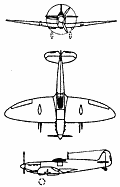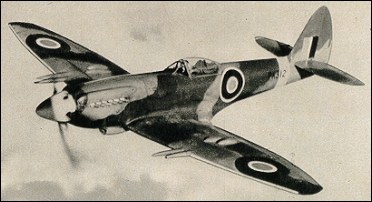|
| Without doubt the best known British aircraft of World War II, the Supermarine Spitfire originated
from the Type 224 designed by R. J. Mitchell to meet the requirements of Specification F.7/30. A cantilever low-wing monoplane of all-metal construction, it had an inverted-gull wing and 'trousered' fixed main landing gear, and was powered by a 447kW Rolls-Royce Goshawk II Vee engine. When the Type 224 was tested its performance proved disappointing, and it was no more successful than any of the other submissions to this specification; none of them gained an Air Ministry contract.
Given a free hand to design a new single-seat fighter unfettered by official specifications, Mitchell outlined on his drawing board the delightful Type 300. Smaller, sleeker and with drag-reducing retractable landing gear, it was tailored around the new Rolls-Royce P.V.12 (Merlin) engine; the wings were not only of distinctive elliptical shape, but they housed eight machine-guns, all of them firing outside the propeller disc. Air Ministry Specification F.36134 was drawn up around the Type 300 and a prototype was ordered. It was powered by a 738kW Rolls-Royce Merlin C and flew for the first time on 5 March 1936. Comparatively little flight testing was needed to confirm it as a winner, and its superb handling qualities and performance resulted in a first contract (for 310 Spitfire Mk I aircraft) being awarded on 3 June 1936. However, planned mass production was slow to gain momentum and it was not until July 1938 that the first Spitfire Mk I reached No. 19 Squadron at Duxford; only five had been delivered by the time of the Munich crisis in September of that year, but the trickle was eventually to become a flood that totalled 20,334 Spitfires and 2,556 related new-build Seafire naval fighters. A degree of multi-role capability was to result from the development of low-altitude clipped wings (prefix LF), and high-altitude increased-span wings (HF), the standard wing being identified as F, and with variations of armament within these wings comprising eight machine-guns (suffix A), two cannon and four machine-guns (B), four cannon (C) and two cannon, two 12.7mm machine-guns and up to 454kg of bombs (E).
By the outbreak of war on 3 September 1939, the RAF had nine operational Spitfire squadrons, and on 16 October 1939 a Spitfire of No. 603 Squadron claimed the first German aircraft to be destroyed over the UK in World War II, a Heinkel He 111. By August 1940, shortly before the Battle of Britain reached its climax, RAF Fighter Command could call upon 19 Spitfire Mk I squadrons. By December 1940 Spitfire Mk IIs were carrying out 'Rhubarb' sweeps over occupied Europe, and the first to serve overseas were Spitfire Mk VBs flown to Malta from HMS Eagle on 7 March 1942.
Soon after that date the same mark was operational in the Middle East, and by early 1943 the first Spitfire Mk Vs were arriving in the Pacific theatre. In growing numbers and with increasing capability the Spitfire served throughout World War II, not only with the RAF but with the nation's allies, including US and Soviet squadrons. It also had the distinction of remaining in production throughout the entire war and was operational post-war, the last mission flown by a photo-reconnaissance Spitfire PR.Mk 19 of No. 81 Squadron in Malaya on 1 April 1954.
 | A three-view drawing (592 x 919) |
| MODEL | Spitfire Mk VA |
| ENGINE | 1 x Rolls-Royce Merlin 45, 1102kW |
| WEIGHTS |
| Take-off weight | 2911 kg | 6418 lb |
| Empty weight | 2267 kg | 4998 lb |
| DIMENSIONS |
| Wingspan | 11.23 m | 37 ft 10 in |
| Length | 9.12 m | 30 ft 11 in |
| Height | 3.02 m | 10 ft 11 in |
| Wing area | 22.48 m2 | 241.97 sq ft |
| PERFORMANCE |
| Max. speed | 594 km/h | 369 mph |
| Ceiling | 11125 m | 36500 ft |
| Range w/max.fuel | 1827 km | 1135 miles |
| ARMAMENT | 8 x 7.7mm machine-guns |
| paul scott, e-mail, 15.10.2009 21:57 As Ember says, the armament was pretty bad but a superb machine nevertheless. Everyone's got their favourite, it's easy to say the Mustang, even the P-47, or the F-4 Corsair, the FW190, but probably the Mustang had it all, with its long range. reply | | Ian Cognito, 23.09.2009 09:32 The true adventures of Sqd Ldr's Tobin and Martindale diving a specially instrumented Spitfire XI are well documented. The Mk XI had a clean wing without gun blisters and ports. The aircraft, EN409, had a special Rotol propeller which could be fully feathered. They achieved 606 mph, Mach .891 although Martindale had to glide in since his prop flew off. reply | | Ronald, e-mail, 23.09.2009 07:08 When the Spitfire fought Sagittarios over Sicily it met it's match. If one got on it's tail, it could not be shaken. Even in diving turns.
Enter the Mk XIV. Dive red-line was 647 mph, terminal velocity was said to be 677 mph! (mach .89) reply | | Leo Rudnicki, e-mail, 22.07.2009 06:40 What about the two- and six- bladed versions? reply | |
| | Sgt.KAR98, 22.07.2009 03:14 US used Spitfires?
And what are the versions of the three,four and five bladed Spitfires? reply | | Ronald, e-mail, 23.06.2009 04:57 The Mk 1 Spitfire took 19 seconds to turn full circle.
Best roll-rate was 105 degrees /second @ 200 mph.
The clipped wing Mk V rolled 150 degrees /second @ 200 mph. reply | | Richard James, e-mail, 22.11.2008 17:16 There is as saying in engineering, 'If it looks right it is right', it was more than 'right' it was perfect! To watch a Spitfire in flight and to hear the Merlin is pure magic. reply | | Ronald, e-mail, 20.09.2008 09:27 The US was wise to have some Spitfires in their inventory.
It was good at turns even at high altitudes which it could reach quickly. This was helped by it's small internal fuel load which is fine for a short range interceptor.
After it finally developed the engine to follow a German in a negative 'g' dive and grew a pair of cannon, it could survive quite well, thank you. Even in the Pacific it was good for interceptor work. It wasn't sturdy enough to really excel at carrier landings though. The Mk VIII followed the Mk IX (curiously enough). It was strengthened and longer ranging. The Mk VIII was a pilots favorite to fly. By the time the Mk XIV went into action in western Europe the Luftwaffe largely abandoned the higher altitudes to it. This Griffin powered Spit was a sensational performer but was a handful for the pilot too. Later Mk XIVs finally had teardrop canopies for better view.
The first Allied type to bag the Me 262 jet says more than I can. reply | | Ronald Sumner, e-mail, 08.07.2008 11:38 A Fantastic well designed machine..,to undergo many improvements..,including haveing its( Main Wings clipped )to improve performance,looks to improve to...,in model form R /C not reproduced reply | | stephen russell, e-mail, 15.06.2008 03:52 Love 2 ride in this but need wider cockpit & 2nd place rear seat.
Classic for all time.
Add wing cannons & MG.
& or underwing rockets.
Any for fee rides in the UK? reply | | EMBER, e-mail, 22.12.2007 23:54 ARMAMENT COULD HAVE BEEN BETTER DURING THE BATTLE OF BRITTEN. AT LEAST IT DID IMPROVE. reply | | gordon williamson, e-mail, 07.09.2007 04:33 In my opinion the Spitfire is the most beautiful aircraft ever flown. I had the privelege of sitting in the "Manston Spitfire" on a trip to England in 2000. I have loved it since I was a little boy. reply | | sergio, e-mail, 24.01.2007 21:08 cual es la diferensia del supermarine spitfire del seafire reply | | Robert Peckham, e-mail, 17.02.2007 19:19 The book 'SPITFIRE A Test Pilot's Story" by Jeffrey Quill is a good read for those wishing to learn more about the development of this aircraft. reply |
|
Do you have any comments?
|
| 
COMPANY
PROFILE
All the World's Rotorcraft
|







